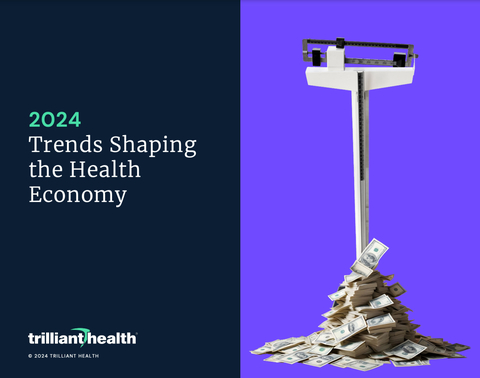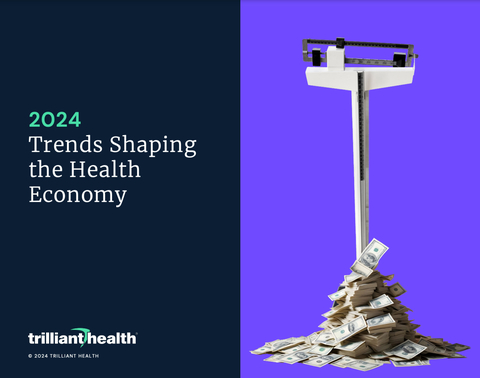BRENTWOOD, Tenn.--(BUSINESS WIRE)--Trilliant Health, the healthcare industry’s leading analytics and market research firm, today released its 2024 Trends Shaping the Health Economy Report, a fact-based national analysis of the trends that will define the landscape, and subsequent challenges, for all players in the health economy.
“As an admirer of Mary Meeker’s Internet Trends reports, I have long believed that our industry needed an analogous, data-driven view of emerging healthcare trends,” said Trilliant Health Chief Research Officer Sanjula Jain, Ph.D. “In the fourth installment of our Trends Shaping the Health Economy Report, we expand upon our foundational conclusions from the past three years to examine in more detail the concept of value.”
The U.S. health economy is the most expensive health system in the world, underwritten by the Federal government, state Medicaid programs and employers. National health expenditures increased from $2.8T in 2012 to $4.5T in 2022, despite relatively little change in demand or utilization, and are projected to grow to $7.7T by 2032.
Americans have little to show for the continuously increasing amount of money invested in the U.S. healthcare system. The average life expectancy for Americans is only negligibly higher than it was in 2000 and is almost four years lower than other OECD countries. Americans have higher rates of obesity and diabetes and more behavioral health conditions than ever before. Mandated reporting of quality measures has failed to reduce mortality, with 30-day hospital mortality rates rising sharply since 2021, even when excluding patients with a primary or secondary COVID-19 diagnosis.
“Every knowledgeable stakeholder must acknowledge that the inputs of the U.S. healthcare system, as measured by cost, exceed the outputs, as measured by the actual value or benefits received by Americans,” said Jain. “Every stakeholder can – and must – deliver more value for money to their customers.”
The report is organized into eight sections, each examining a significant macro trend:
- The healthcare system is disproportionately expensive.
- Health status will continue to decline.
- Government innovation and regulation are failing to produce value.
- The value of technological advancements is uncertain.
- Supply constraints are correlated with inadequate yield.
- Forced consumerism has fostered fragmentation.
- Lower-cost care settings can offer better value.
- Employers are better equipped to demand value for money.
Supporting the eight macro trends are 130+ data-driven stories about the past, present and future of the U.S. healthcare system, including:
- Health status continues to decline, especially for younger Americans. Mortality remains higher than pre-pandemic, with the largest increase in the 18-44 age group (p. 17).
- Early onset cancers are rising, with higher volumes of patients ages 45 and younger for breast (+6.6%), colon (+10.0%), kidney (+2.1%) and uterine (+16.0%) cancers from Q4 2018 to Q4 2023 (p. 22).
- Behavioral health volumes are increasing, with eating disorders (+14.2%), schizophrenia (+14.0%), ADHD (+11.1%) and anxiety disorders (+10.7%) all trending up from Q1 2019 to Q4 2023 (p. 31).
- Liver-related utilization and mortality are growing among younger men, with a substantial increase of 66.0% in visits for alcoholic liver disease for men ages 18-39 from 2018 to 2023 (p. 41).
- Patient volume for several autoimmune diseases is rising, with ulcerative colitis (+28.9%), celiac disease (+21.5%), Crohn’s disease (+14.6%) and lupus (+12.7%) increasing between Q1 2019 and Q4 2023. (p. 42).
- Value-based care programs through CMMI are projected to generate a net increase in Medicare spending by $9.4B by 2026. Since its establishment by the Affordable Care Act (ACA), CMS has tested numerous VBC models, producing limited reductions in spending or improvements in quality (p. 49).
- Actual usage for clinical artificial intelligence (AI) remains low, with only 202K patients across all AI CPT codes between 2018 and 2023. Utilization of AI technologies is highest for cardiac conditions such as coronary artery disease, ECG cardiac dysfunction and coronary atherosclerosis (p. 77).
- GLP-1s have surpassed insulin to become the second most common medication for type 2 diabetes in 2023, rising from the eighth most common drug regimen in 2018. The growing use of GLP-1s has increased the downstream use of gastrointestinal treatments (pp. 80-83).
- Telehealth usage has declined by over 40.0% since its peak in Q2 2020. However, its application for behavioral health has grown steadily and now represents 72.3% of telehealth volumes (p. 137).
- As nearly half of Americans struggle to afford healthcare, prices vary widely across the nation. Across a basket of four common heart and vascular surgical procedures in select competitive markets, the hospital-level median negotiated rate ranged from $26.5K in St. Louis to $153.8K in New York City (p. 109; p. 149).
In addition to the public report, subscribers to the enterprise tier of Compass+, Trilliant Health’s research subscription, receive a second report, the Health Economy Trends Report: Micro Edition.
“This year, for our Compass+ subscribers, we have provided additional context for each trend as a way for health economy stakeholders to understand how to develop actionable strategies in response to the health economy’s evolution,” said Jain. “The Micro Edition explores how national trends vary by region and CBSA, by patient cohorts and by insurance type.”
Read the public report: https://www.trillianthealth.com/market-research/reports/2024-health-economy-trends
About Trilliant Health
Trilliant Health combines healthcare industry expertise, market research and predictive analytics to form Evidence-Based Strategy for Healthcare™. Trilliant Health's proprietary analytics platform produces a comprehensive understanding of local market dynamics providing exponentially better data insights to maximize returns from growth strategies.




